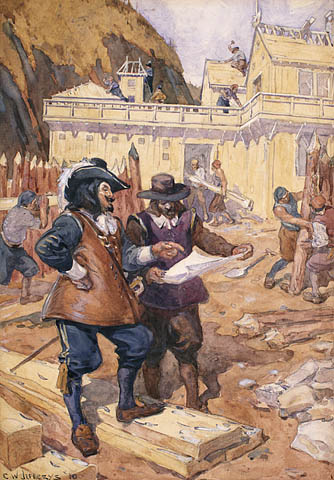The Battle of Long Sault took place over ten days in May 1660, pitting the French of the Ville-Marie colony and their Wendat and Algonquin allies against a much larger Haudenosaunee contingent. The French, led by Adam Dollard des Ormeaux, were completely decimated in the battle. For centuries Adam Dollard des Ormeaux’s actions were considered heroic, as he was believed to have prevented the Haudenosaunee from attacking Ville-Marie. Recent studies, however, have cast doubt on the accounts of the battle, Adam Dollard des Ormeaux’s intentions and the action he took. It is also unclear whether the Haudenosaunee really threatened Ville-Marie.
Historical Context
The Jesuit Relations placed the Battle of Long Sault in the context of decades of warfare between the Wendat and the Haudenosaunee. According to this historical text, the Wendats sought to wage war on the Haudenosaunee in retaliation for the losses they had suffered in previous years.
According to this source, 40 Wendats led by Anahotaha wanted to attack their enemies as they were coming back from hunting. They passed by Trois-Rivières where six Algonquins joined them under Mitiwemeg’s command. The group continued on to Ville-Marie where 17 French joined them under the command of Adam Dollard des Ormeaux. He also wanted to lead a campaign against the Haudenosaunee.
Unlike seasoned Indigenous warriors, French volunteers were less accustomed to war.
Battle of Long Sault
Adam Dollard des Ormeaux and his warriors left Ville-Marie and after several days of canoeing, stopped to ambush the Haudenosaunee. However, they were spotted by an advanced group of some 200 enemies; Adam Dollard des Ormeaux and his comrades took refuge in an old Algonquin fort that had been reduced to a simple palisade. The fort is believed to have been located along the Ottawa River, approximately midway between Ottawa and Montreal, near Carillon today. Its exact location is still debated.
For several days, the Haudenosaunee laid siege to the French and their Wendat and Algonquin allies. In addition, 500 Oneida and Kanienʼkehá꞉ka came to assist the besiegers. The fighting was intense and fierce, but the French and their Indigenous allies had the advantage of firearms, the fort and military experience. During the battle, the Wendat displayed the severed head of an Onondaga chief above the palisade wall.
However, the situation took a turn for the worse for the fort’s defenders. Wendat chief Annahotaha proposed negotiations. Two Wendats and one Oneida went to negotiate with the Haudenosaunee when a group of Wendat adopted by the Haudenosaunee approached the fort and convinced several of their fellow warriors, pointing out that they would be treated better by the Haudenosaunee than by the French. The Wendats started deserting the fort, unwilling to fight to the death for their French allies. In the past, the French had not given the Wendats much support in their struggle against the Haudenosaunee.
As the talks continued, the wary French opened fire on the Haudenosaunee, breaking the truce. The Haudenosaunee resumed their attack, killing Chief Annahotaha. Attacking the palisade walls with hatchets, the Haudenosaunee were able to breach the fortifications. According to the traditional account, Adam Dollard des Ormeaux threw a barrel of gunpowder at the assailants to delay them. The explosive device struck a tree branch and fell back into the fort, seriously injuring the last defenders. It is not known if the explosion killed Adam Dollard des Ormeaux instantly or if he later died of his wounds, but the battle was lost, and the Haudenosaunee were victorious. It is said that only five or seven French and four Wendat survived the battle. The latter were then tortured and killed.

Debate on the Battle’s Historical Representation
Many historians, politicians, journalists and clerics have long held a heroic view of the battle. Many highlighted the bravery of Adam Dollard des Ormeaux and his Indigenous allies, as well as their martyrdom in defence of the faith and New France. François Dollier de Casson’s Histoire du Montréal provides a patriotic and religious interpretation of the actions of Adam Dollard des Ormeaux during the Battle of the Long Sault.
Since the 1930s, historians have questioned this heroic depiction of the battle. They have pointed out, among other things, that neither Adam Dollard des Ormeaux nor the Wendat were aware of the presence of a group of Haudenosaunee warriors in the vicinity of Ville-Marie. Instead, the French and their allies thought they were attacking groups of Haudenosaunee hunters to take their beaver pelts and trade them with a group of Odawa. In addition, according to Dutch reports, only 14 Haudenosaunee were killed and 19 wounded in the battle. It seems unlikely, therefore, that so few casualties would have caused the Haudenosaunee to abandon an assault on Ville-Marie. In retrospect, some argue that Adam Dollard des Ormeaux and his allies were the aggressors while the Haudenosaunee defended themselves.
Heritage
A bas-relief of the battle featuring Adam Dollard des Ormeaux can be found on the pedestal of the Maisonneuve Monument on Place d'Armes in Montreal. (See Paul de Chomedey de Maisonneuve.)

A painting of the battle adorns a wall of the Mont-Royal Chalet at the Kondiaronk lookout.
A commemorative plaque depicting the battle used to be on Highway 344 near Carillon, Quebec, but it has been moved to a new location near Voyageur Provincial Park in Chute-à-Blondeau, Ontario.

 Share on Facebook
Share on Facebook Share on X
Share on X Share by Email
Share by Email Share on Google Classroom
Share on Google Classroom







